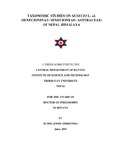Please use this identifier to cite or link to this item:
http://archive.nnl.gov.np:8080/handle/123456789/349| Title: | Taxonomic Studies on Senecio L. s.l. (Senecioninae: Senecioneae: Asteraceae) of Nepal Himalaya |
| Authors: | Joshi (Shrestha), Sudha |
| Keywords: | genus Senecio L. |
| Issue Date: | 24-Mar-2019 |
| Abstract: | The genus Senecio L. of family Asteraceae (Compositae) is one of the largest genera of subtribe Senecioninae of tribe Senecioneae. Traditionally, the genus comprised of ca.3000 species with high morphological variations and found across diverse habitats. The genus has become a subject of various taxonomic interpretations for decades; it is perceived to be highly artificial by many taxonomists because of the fact that many of the species assigned to the genus are found to be closely related to the species of other genera than the core Senecio L. As a result, a number of species has been moved to other existing, new or resurrected genus, based on the morphological, karyological and DNA sequencing. However, in order to overcome the taxonomic problems, taxonomists so far have ignored the micromorphological characters like trichome, stomata and pappus and secondary metabolites in the generic delimitation of Senecio L.. Previously, 24 species of Senecio had been reported in Nepal Himalaya. With the addition of two new reports, there are altogether 26 spp. of Senecio s.l.. According to the present generic delimitation of Senecio, those 26 spp. of Senecio lie within five well-established genera viz. Cissampelopsis, Ligularia, Parasenecio, Senecio and Synotis. Among them, Ligularia and Parasenecio lie within the subtribe Tussilagininae and Cissampelopsis, Senecio and Synotis lie within the subtribe Senecioninae. The present study was confined to Senecio s.l. (1 sp. of Cissampelopsis; 12 spp. of Senecio s.s. and 10 spp. of Synotis) of subtribe Senecioninae found in Nepal. The main aim of the study was to investigate the taxonomic value of various characters, mainly the morphological, both gross and micromorphological, to solve the taxonomic problems in Senecio L. s.l., to identify the taxonomic importance of secondary metabolites in delimiting the species, and to find the interrelationships among the species of Senecio L.s.l.. |
| URI: | http://103.69.125.248:8080/xmlui/handle/123456789/349 |
| Appears in Collections: | 500 Natural sciences and mathematics |
Files in This Item:
| File | Description | Size | Format | |
|---|---|---|---|---|
| SUDHA JOSHI SHRESTHA - Ph. D. THESIS.pdf | 10.04 MB | Adobe PDF |  View/Open |
Items in DSpace are protected by copyright, with all rights reserved, unless otherwise indicated.